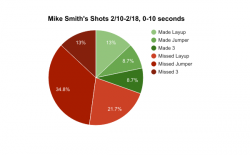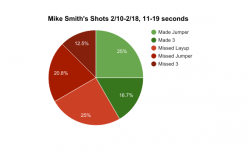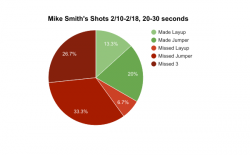After crying over the Lions’ consecutive 4 losses, basketball fan and guest writer Gloriana Lopez decided to crunch more numbers than she ever did when she was in SEAS in hopes of finding a way to stop suffering and make the Lions win their games this weekend against Penn and Princeton. She figured out that maybe Mike Smith might be the key to that.
Mike Smith has quickly become one of the best players in the Men’s Basketball team. As a freshman, he has become the second leading scorer, just behind senior Luke Petrasek, and has racked up the 82 assists. But while Smith takes even more shots than Petrasek (30% of all shots in the last four games, compared to Luke’s 19%), he scores significantly fewer points. There’s no doubt that he knows how to put the ball in the basket, since he leads the offense with Petrasek and junior Nate Hickman… but could he be doing better?
By analyzing every shot Mike Smith took in the last four Ivy games, we can see several predictive factors for Smith’s success. Chief among them is the length of possessions in which Smith shoots – this makes sense, since Smith and Hickman have been instrumental to pushing up the Lions’ tempo. The ideal time for Mike to shoot is when 14 seconds have passed, since most of his misses come either when possession times are too short (between 1 and 10 seconds) or too long (between 20 and 30 seconds). For the purpose of this analysis, we are considering possessions to begin when Columbia gets the ball, and when Columbia rebounds, therefore resetting the shot clock.
This is not to say that speed is not important to have good offense, but that Mike might be rushing to score. When the clock is too low and all possibilities have been exhausted, he feels that he alone has to make a move before the time is up. Conversely, he also struggles when the the play has just begun and right after rebounds. Part of this comes from steals – when the Lions steal and Mike Smith shoots, Smith has only made 2 of 8 attempts over the last two weekends, both of which came 2 seconds after the steal. In an effort to push the tempo at the game’s turning points, Smith is taking low-percentage shots.
Offensive rebounds, our analysis showed, also usually lead to successful field goals, for Mike and everyone else. Rebounds give Smith more time to position himself after the fray of a rebound attempt. However, this post-rebound advantage vanishes when the possession drags on too late past the rebound, and those long fruitless positions hurt team morale (after someone on your team misses and you have to shoot again with these giant dudes are all over you, you would be frustrated too, right?).
Smith’s not a classic ball hog – he knows how to set up teammates, and has the team’s most assists. But can he take assists from everyone else? In the past four games, out of the 23 field goals he has made, he has been assisted only 5 times: Most of the time, when he attempts a field goal, he drives on his own. For reference, the team assist rate is a clean 60%. This could mean that Mike likes to have control over the ball and the plays, but it could also signal a sort of stubbornness with the ball. Who hurt you Mike? Why do you have trust issues? Trusting himself to get to the basket has definitely made Smith successful, but he might find more success letting his teammates set him up in the middle of the shot clock.
Our favorite crazy child via Columbia University Athletics/Mike McLaughlin


 0 Comments
0 Comments



